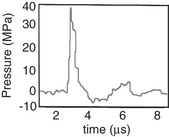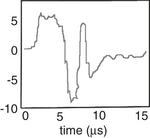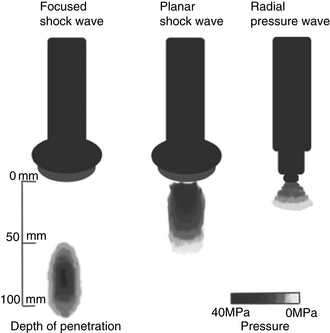CHAPTER 116 Extracorporeal Shock-Wave Therapy and Radial Pressure-Wave Therapy
Over the last 10 years, shock-wave equipment has evolved quickly. The original dry lithotripters were large with solid matriculating arms and complex aiming devices. The adaptation of shock waves to equine therapy has necessitated equipment with more flexibility and portability. Most equine applications do not require the fluoroscopic and ultrasonographic aiming devices that were included in the original equipment. A number of machines that meet these needs of the equine practitioner are now available. Concurrently with the increased popularity of shock-wave therapy, radial pressure-wave therapy has also become more common for equine applications. This technology evolved from equipment used in mechanical testing equipment.
Radial pressure waves have a rise time consistently around 1 us, and the highest peak pressure is about 8 MPa. None of the waveforms has a shock front. A notable difference between the pressure waveforms is the ability of the wave to propagate with minimal loss of energy. Shock waves can propagate through a fluid medium with minimal loss of energy, which permits a large amount of energy from the shock wave to penetrate the body. Radial pressure waves decrease in energy proportional to the square of the distance from the applicator head. Clearly the machines are different (Table 116-1 and Figure 116-1). The mechanism of action of shock waves and radial pressure waves is not fully understood and may be different, but both can induce biological effects. Conflicting results among studies suggest that further evaluation of equipment and energy settings is required.
Table 116-1 Comparison of shock and Radial Pressure Waves
| Variable | Shock Waves | Radial Pressure Waves |
|---|---|---|
| Wave form |  |  |
| Rise time | 5-10 nanoseconds | 50 microseconds |
| Focusing | Yes | No∗ |
| Maximum pressure location | At focal point | On surface |
| Energy loss | Minimal through fluid and tissue | Loss proportional to the square of the distance |
| Peak pressure | ≈100 MPa | ≈10 MPa |
| Energy flux density | 0-3 mJ/mm2 | 0-0.3 mJ/mm2 |




